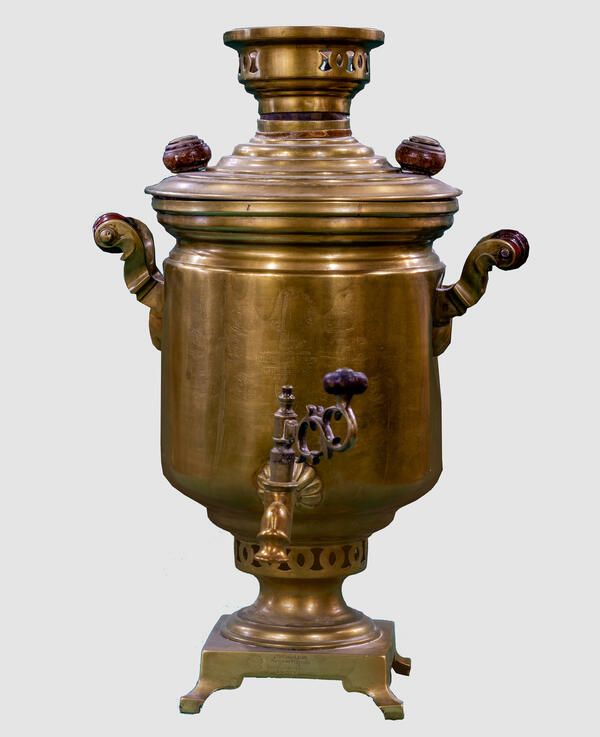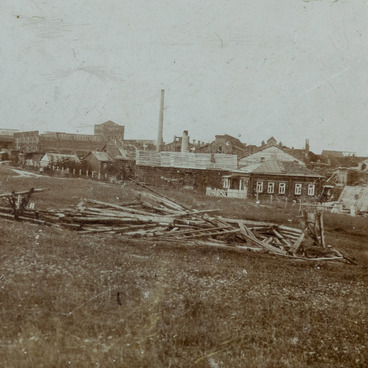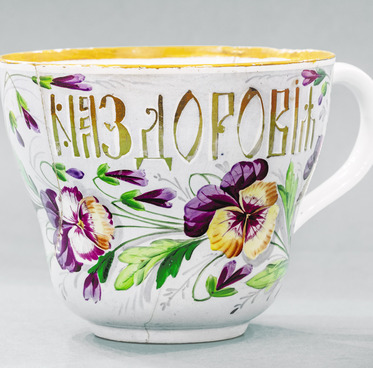A samovar was an indispensable part of any Russian tea party. Tula was the center of samovar manufacturing. Nikolai Batashev was a famous samovar manufacturer from Tula, the son and heir of Ivan Batashev. In 1848, Ivan Batashev was granted the title of the Purveyor to His Imperial Majesty’s Court. In 1850, for high quality of his products and long-standing participation in samovar manufacturing, Batashev was awarded with the right to stamp the image of the National Emblem of Russia on his samovars.
In 1880, his son Nikolai Ivanovich Batashev became the sole owner of his factory. At the World’s Fair in Moscow in 1882 he received a golden medal for exceptional quality of his samovars and hardware.
Batashev’s new factory was finished at the end of the 19th century in Tula. In the early 20th century, the factory produced 54 different types of samovars. Batashev’s samovars, famous for their high quality and decoration, were highly valued and quickly sold out, which brought considerable profit. Not a single Russian exhibition, in or out of Russia, was held without the Tula samovar, manufacturing on Batashev’s factory. At the end of the 19th century, Vasily Batashev received a golden medal in New York. His products were praised for their great quality and functionality.
His company’s products were much better than analogues manufactured by competitors. His samovars were extremely durable, made from metal of outstanding quality. Batashevs' samovars quickly became popular all over Russia: both in cities and in the countryside. High-qualified employees who got decent salary also contributed to the quality of the product.
In 1906, the Batashev brothers opened an elementary school where they shared the secrets of making a really good samovar. On a real Tula samovar made on the Batashevs' factory you will always find numerous engravings of medals. Only the purveyors to the Russian Imperial Court or to the royal courts of Europe had the right to put such stamps on their products. This way, they could make their craft stand out.
Batashevs' samovars were extremely popular a few centuries ago, and even today, they remain highly sought-after among collectors. On average, a real Batashevs' samovar costs from 30,000 to 100,000 rubles.
In 1880, his son Nikolai Ivanovich Batashev became the sole owner of his factory. At the World’s Fair in Moscow in 1882 he received a golden medal for exceptional quality of his samovars and hardware.
Batashev’s new factory was finished at the end of the 19th century in Tula. In the early 20th century, the factory produced 54 different types of samovars. Batashev’s samovars, famous for their high quality and decoration, were highly valued and quickly sold out, which brought considerable profit. Not a single Russian exhibition, in or out of Russia, was held without the Tula samovar, manufacturing on Batashev’s factory. At the end of the 19th century, Vasily Batashev received a golden medal in New York. His products were praised for their great quality and functionality.
His company’s products were much better than analogues manufactured by competitors. His samovars were extremely durable, made from metal of outstanding quality. Batashevs' samovars quickly became popular all over Russia: both in cities and in the countryside. High-qualified employees who got decent salary also contributed to the quality of the product.
In 1906, the Batashev brothers opened an elementary school where they shared the secrets of making a really good samovar. On a real Tula samovar made on the Batashevs' factory you will always find numerous engravings of medals. Only the purveyors to the Russian Imperial Court or to the royal courts of Europe had the right to put such stamps on their products. This way, they could make their craft stand out.
Batashevs' samovars were extremely popular a few centuries ago, and even today, they remain highly sought-after among collectors. On average, a real Batashevs' samovar costs from 30,000 to 100,000 rubles.



